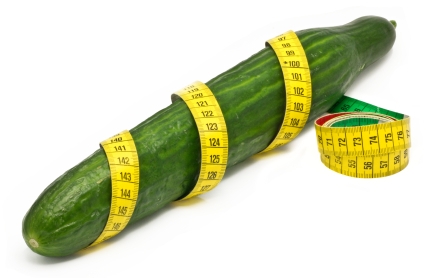Sex Question Friday: What Is The Average Penis Size?
August 2, 2013 by Justin Lehmiller

One of the most common questions I get from students in my classes and readers of the blog concerns the average or typical penis size. Unfortunately, this is one of the hardest questions to answer with any degree of certainty because the research in this area is fraught with problems. Traditionally, researchers have adopted one of two approaches to studying penis size: self-report vs. clinical measurement. In self-report studies, guys are provided with standardized instructions on how to measure their penises and then asked to report their size. In clinical measurement studies, guys need to drop their trousers and become aroused in front of a trained scientist who performs all of the measurements. The concern with the self-report method is that guys will lie or exaggerate, while the concern with the clinical measurement studies is that only more well-endowed men will opt to participate. Both methods are therefore thought to artificially inflate the average. However, a clever new study published in the Journal of Sexual Medicine reveals a new method for obtaining perhaps even more accurate data on penis size and presents some findings that may surprise you.
In this study, 1,661 sexually active men aged 18 and older who were living in the United States were recruited for a study on condom fit and feel [1]. The men were asked to self-report on their penile dimensions, but were informed that they would be provided with custom fit condoms in exchange for this information. Thus, the men had a strong incentive and motivation to report their size accurately, otherwise they would run the risk of receiving condoms that were too big or too small and, therefore, of no use. All men downloaded a measurement tool that that they could print from their computer and use to measure their erect penile length and circumference (i.e., “girth”).
Results revealed that the average erect penile length was 14.15 cm (5.57 inches), while the average penile circumference was 12.23 cm (4.81 inches). Participants whose partners helped them become erect for the measurement by providing oral stimulation reported larger penises than those who used other methods of achieving an erection (e.g., fantasy, masturbation). No associations were found between penis size and participant age, race, or sexual orientation. However, it is important to note that the sample was predominately young (90.2% were aged 18-39), White (82.8%), and heterosexual (88.1%). Thus, some of the subgroups were too small to perform meaningful statistical comparisons. As a result, these findings should not be interpreted as being characteristic of all men—rather, these data speak primarily to young, White, heterosexual men in the U.S. who were interested in receiving a fitted condom.
Perhaps the most interesting and surprising thing about these data is how consistent the results were with studies of penis size based upon clinical measurements, which have reported average lengths in the range of 12.9-14.5 cm (5.1-5.7 inches) and circumferences in the range of 11.9-12.3 cm (4.7-4.8 inches) [2]. If we contrast the new data with self-report studies in which men did not have an incentive to report accurately (i.e., where no custom fit condoms were offered), the average numbers skewed quite a bit higher, with lengths ranging from 15.6-16.6 cm (6.1-6.5 inches) and circumference ranging from 12.2-13.6 cm (4.8-5.4 inches) [2]. Thus, the methods used in the new study appeared to reduce men’s tendency to exaggerate.
Although the sample used in this study is certainly not representative of all men, this study makes an important contribution to sexual science by developing what appears to be a highly accurate and non-invasive method of determining penis size. If this method were applied more widely, it could potentially help us to better understand diversity in penis size across different demographic groups and finally provide a more definitive answer to the question of what average is.
Want to learn more about The Psychology of Human Sexuality? Click here for a complete list of articles or like the Facebook page to get articles delivered to your newsfeed.
[1] Herbenick, D., Reece, M., Schick, V., & Sanders, S. A. (2013). Erect penile length and circumference dimensions of 1,661 sexually active men in the United States. The Journal of Sexual Medicine.
[2] Reece, M., & Herbenick, D. (2006). Rates of condom breakage and slippage using a condom fitted to penile length and circumference. European Journal of Sexual Health, 15(S1), 36.
Image Source: iStockphoto.com
You Might Also Like:

Dr. Justin Lehmiller
Founder & Owner of Sex and PsychologyDr. Justin Lehmiller is a social psychologist and Research Fellow at The Kinsey Institute. He runs the Sex and Psychology blog and podcast and is author of the popular book Tell Me What You Want. Dr. Lehmiller is an award-winning educator, and a prolific researcher who has published more than 50 academic works.
Read full bio >

